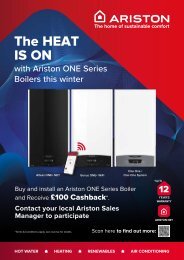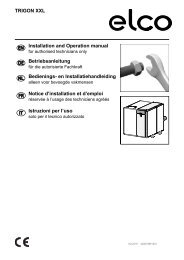Nimbus Compact M NET R32 Installation Manual UK
You also want an ePaper? Increase the reach of your titles
YUMPU automatically turns print PDFs into web optimized ePapers that Google loves.
Service<br />
i<br />
– Automatic deaeration valve.<br />
To check the condition of the discs, it is necessary to<br />
access the upper part of the valve and dismantle it.<br />
If the disc appears to be damaged and/or has expanded<br />
to the point of obstructing (even partially) the air outlet<br />
hole, it must be replaced. The discs tend to wear out<br />
more when the supplementary heating element is used<br />
frequently.<br />
– Automatic deaeration function.<br />
Remove all the air present in the hydraulic circuit. Upon<br />
the initial start-up, an automatic deaeration cycle of the<br />
system will start. During the maintenance phase it is<br />
possible to set the Air Purge Function 1.12.0 to start an<br />
automatic deaeration cycle.<br />
The air purge cycle should be repeated whenever the<br />
deaeration does not appear to have been sufficient.<br />
– 2 Zones (if present).<br />
Maintenance of the hydraulic components of the<br />
2-zone model must be carried out on the rear of<br />
the product.<br />
Checklist for annual maintenance of the electrical connections.<br />
Check the following elements at least once a year:<br />
– Electrical panels<br />
Open the electrical panels of the outdoor and indoor<br />
units and perform a visual inspection to verify that there<br />
are no evident defects, particularly with regard to the<br />
terminal boards. Check the tightness of the connection<br />
wire by wire so as to avoid potential loosening of any<br />
connection. In no case must there be any wires that are<br />
not connected to a terminal.<br />
– Cabling<br />
Check that all cable connectors are appropriately connected<br />
to their respective boards and that no elements<br />
are disconnected.<br />
– Supply voltage check.<br />
– Electrical absorption check.<br />
Checklist for annual maintenance of the domestic hot<br />
water storage tank (if included in the system).<br />
Check the following elements at least once a year:<br />
– Limescale removal.<br />
When using the device with very hard water, it is advisable<br />
to use an adequate scale remover.<br />
a<br />
– Safety valve (if installed).<br />
The safety valve is used to protect the storage tank and<br />
the heat exchanger for domestic hot water production<br />
against overpressure. Consequently, its operation must<br />
be checked frequently and it must be inspected to ensure<br />
that it is not obstructed by limescale deposits of<br />
other residues. When expansion vessels are used, the<br />
safety valve is normally not subject to stress. However,<br />
over an extended period of time, it may stop working.<br />
Replace it if it is damaged.<br />
It is normal that water drip from the overpressure safety<br />
device when the appliance is heating. For this reason<br />
one must install a drain, open to the air, with a continuously<br />
downwards sloping pipe, in an area not subject to<br />
subzero temperatures.<br />
– Passive anode.<br />
This product is equipped with two magnesium anode rods.<br />
Anode rods are sacrificial components that counteract water<br />
chemistry to minimize or eliminate tank corrosion.<br />
The anode rods should be inspected at least annually<br />
and replaced as necessary to prolong tank life. Have the<br />
supply water quality professionally analyzed, as local<br />
water conditions will influence the duration for inspection<br />
and replacement of the anode rod.<br />
Some installation conditions necessitate more frequent<br />
inspection of the anode rods. The use of a water softener<br />
may increase the speed of anode consumption.<br />
For example, more frequent inspection of the anode is<br />
needed when using softened or treated water.<br />
NOTE: Failure of the tank due to lime scale build-up on<br />
the heating surface, low pH, or other imbalance IS NOT<br />
covered by the warranty.<br />
NOTE: Do not remove anode rods from an operating<br />
water heater. Operating the product without anode rods<br />
will shorten the life of the tank and VOID the warranty.<br />
NOTE: If anode rods are rapidly consumed water chemistry<br />
should be tested by a qualified technician. Corrective<br />
action should be taken to prevent the premature<br />
failure of the water heating system. Operating the product<br />
with fully consumed anode rods will shorten the life<br />
of the tank and VOID the warranty.<br />
– Hydraulic safety assembly (if installed).<br />
For countries that have implemented the EN 1487 European<br />
standard, domestic storage water heaters and similar<br />
appliances must be connected to the mains water using<br />
an appropriate hydraulic safety assembly. The hydraulic<br />
safety assembly supplied with the appliance (if present)<br />
does not conform to this standard; it is therefore necessary<br />
to install an additional device supplied as an accessory.<br />
If installed, periodically check that the drainage pipe<br />
is adequately positioned for draining water (refer to the<br />
installation instructions) and remove any obstructions.<br />
– Risk of freezing.<br />
If there is a risk of frost, the tank must be heated or emptied<br />
completely.<br />
– Cleaning of external parts.<br />
The external parts must be cleaned with a damp cloth.<br />
Avoid using solvents or detergents.<br />
Ensure that the area is in the open or that it is<br />
adequately ventilated before breaking into the<br />
system or conducting any hot work.<br />
EN / 73

















